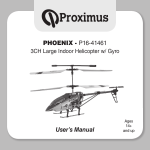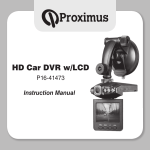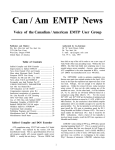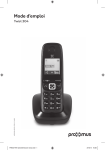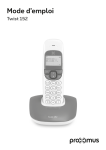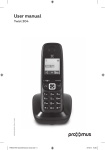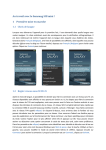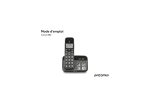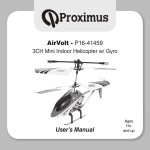Download Proximus THUNDER STRIKE P16-41460 User`s manual
Transcript
THUNDER STRIKE - P16-41460 4CH Indoor Helicopter w/ Gyro User’s Manual Ages 14+ and up TABLE OF CONTENTS What’s in the Box.................................................................................................... 3 Helicopter Part List................................................................................................. 4 Infrared Control Transmitter.................................................................................... 4 Installing the Batteries............................................................................................ 5 Charging the Helicopter.......................................................................................... 6 Pre-Flight................................................................................................................ 7 Troubleshooting...................................................................................................... 9 Care & Maintenance............................................................................................. 10 FCC Information................................................................................................... 10 2 WHAT’S IN THE BOX a.- (1) Helicopter e.- (1) Spare Balance Bar b.- (1) Remote Control f.- (1) Spare Ascend and Descend Landing Gear c.- (4) Spare Screws g.- (2) Spare Tail Blades d.- (2) Spare Main Blades h.- (2) Spare Connection Buckle b a e f d c h g 3 HELICOPTER PART LIST Specifications Size: 7.87”x1.37”x4.13” Main Rotor: 6.81” Battery: Li-poly 3.7v 150mAh Stabilizer Main Rotor Blade Tail Rotor Light Light Gear INFRARED CONTROL TRANSMITTER Power Indicator Band Selector Power Switch Trim Directional Stick (Forward/Backward/Left/Right) Throttle Stick (Ascend/Descend/Left/Right) Running/Flying Mode Switch Charging Cable Cover 4 INSTALLING THE BATTERIES 1. Turn the remote control over to access the battery compartment on the back. 2.Remove the screw and remove the battery compartment cover 3.Insert 6 AA batteries making sure to orient them according to the illustrations on the inside of the battery compartment. 4.Replace the cover ensuring to fasten the screw. Battery Notes: • Do not mix new and old batteries or different brands of batteries. • When not in use, switch off the power switch to extend usage time • When the indicator lights of the controller flash, the controller is low on power. Make sure to change the batteries before they are completely drained. • If you don’t use the transmitter for an extended period of time, remove all batteries in order to avoid leakage. 5 CHARGING THE HELICOPTER • Make sure to switch OFF the helicopter prior to charging. • Use the remote control’s charging cable located behind the front panel OR use the included USB cable to charge the helicopter using any available USB power port. Charging Socket Charging Cable Power Switch Battery Notes: • Do not use or leave the battery near a heat source such as fire or heater. • Do not allow the battery to be immersed in water. Make sure to keep the battery in a cool and dry environment. • Do not disassemble the battery. • Never leave the battery unattended during charging. • When not in use, switch off the power switch to extend usage time • The control distance will shorter when the battery is not fully charged. 6 PRE-FLIGHT 1. Lay your helicopter on the ground at least 6 feet away from obstructions, animals or people. 2.Move the helicopter’s power switch located in the main housing to ON and make sure the throttle on the remote is in the down position. 3.Stand back, and switch the remote’s power switch to ON. 4.Increase pressure on the throttle stick until the helicopter is able to just barely hover over the floor. 5.Back off on the throttle to maintain a steady height and check to see if the helicopter leans in one direction or spins. If the helicopter is not stable hovering over the floor, make micro-adjustments to the trim dials on the remote control to correct. You may also use the included screwdriver to adjust the potentiometer located on the helicopter’s circuit board. 6.Use very slight right and left adjustments to test the helicopter’s ability to move right and left 7 Notes: • Do not fly in extreme temperatures above 113°F/45° C, or below 50° F/10° C as doing so will affect performance and may damage the helicopter. • Do not fly in strong wind as windy conditions will limit control ability. • Select a large, wide-open area and make sure there are no obstructions, animals or people nearby. • If your helicopter is heading for a collision with a spectator or hard object, cut the throttle to prevent damage. • If there is not enough power to lift off your battery may be low. Charge the helicopter and try again. 8 TROUBLESHOOTING PROBLEM CAUSE CHECK THIS The remote control doesn’t work The power switch on the remote control is OFF Make sure the Power switch is set to is ON The batteries are improperly inserted Confirm batteries are correctly inserted. Batteries lack of power Change the batteries The power switch on the helicopter is OFF Turn helicopters power switch ON Main rotor blades are rotating too slowly Pull up on the throttle stick The helicopter isn’t charged sufficiently Charge the helicopter. The remote control doesn’t work Unable to control the helicopter Helicopter unable to rise 9 CARE AND MAINTENANCE Warning 1. Recommended for indoor use only, and only in rooms without obstacles, breakable objects or fans. 2. If the helicopter becomes damaged or broken do not fly as it may lead to injury. FCC INFORMATION This device complies with Part 15 of the FCC Rules. Operation is subject to the following two conditions: 1) This device may not cause harmful interference. 2) This device must accept any interference received including interference that may cause undesired operation. 10 Warning: Changes or modifications to this unit not expressly approved by the party responsible for compliance could void the user’s authority to operate the equipment. Note: This equipment has been tested and found to comply with the limits for a Class B digital device, pursuant to Part 15 of the FCC Rules. These limits are designed to provide reasonable protection against harmful interference in a residential installation. This unit uses and generates radio frequency energy and if not installed and used in accordance with the instructions, may cause harmful interference to radio communications. However, there is no guarantee that interference will not occur in a particular installation. If this equipment does cause harmful interference to radio or television reception, which can be determined by turning the equipment off and on, the user is encouraged to try and correct the interference by one or more of the following measures: • Reorient or relocate the receiving antenna. • Increase the separation between the equipment and receiver. • Connect the equipment to an outlet on a circuit different from that to which the receiver is connected. • Consult the dealer or an experienced radio/TV technician for help. 11 Proximus Products 8300 West Flager St. Suite# 121-106 Miami, FL 33144 Technical Support: 1(888) 222-5487 Proximus™ is a registered Trademark of Streak Products, Inc. © 2011 Streak Products, Inc. 12












